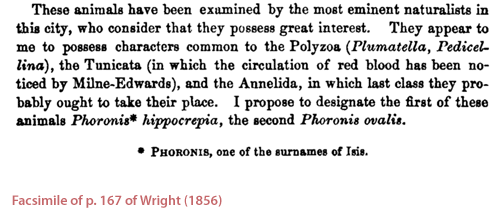| Phoronida: vernacular or common names | ||
|
||
| Definitions and ICZN articles | ||
The definitions in the dictionary:
Note: Both definitions being similar, vernacular name will be used herein - it is originally used in the Code below The rules of the "International Code of Zoological Nomenclature" (ICZN, 1999) which apply to all animal species and genus, related to these two names are quoted below:
Some comments and remarks : In biology, a vernacular name of a taxon or organism (also known as a common name, English name, colloquial name, trivial name, trivial epithet, country name, popular name, or farmer's name) is a name that is based on the normal language of everyday life; this kind of name is often contrasted with the scientific name for the same organism, which is Latinized. Sometimes vernacular names are created by scientific authorities on one particular subject, in an attempt to make it possible for members of the general public (including such interested parties as fishermen, divers, etc.) to be able to refer to one particular taxa among the hierarchical classification of organisms without needing to be able to memorise or pronounce the Latinized scientific name. Furthermore the above cited article 12.3 (ICZN, 1999), a scientific sheet or report on a species must not include one or more vernacular names in order to avoid any misinterpretation and simple confusion:
|
||
| Phoronida | ||
Two vernacular names can be used in the phylum Phoronida: horseshoe worm or phoronid in English. In other languages: phoronidien (French), foronide (Italian), foronídeo (Spanish), Hufeisenwurm, Phoronide (German), Hoefijzerworm (Dutch), phoronida (Portuguese). The larva of the Phoronida is named Actinotrocha, which vernacular name is actinotroch. Remember that, contrary to what can often be read, the name Phoronis is one of the many epithets of the Egyptian goddess Isis, as stated by Wright (1856) when creating the genus. It is therefore a feminine name (see also Selys-Lonchamps, 1907).
|
||
| References | ||
|
See: "common name" in Wikipedia ICZN - International Code of Zoological Nomenclature (1999). http://iczn.org/code, accessed in 2017. Hatschek B., 1888. Lehrbuch der Zoologie : eine morphologische Übersicht des Thierreiches zur Einführung in das Studium dieser Wissenschaft. Fischer, Jena, 1e édition, Vol. 2. Selys-Longchamps M. de, 1907. Phoronis. Fauna und Flora Neapel, Friedländer, Berlin, Monographie 30, 1-280. Wright T. S., 1856. Description of two tubicolar animals. Proceedings of the Royal Physical Society of Edinburgh, 1, 165-167.
|
||
